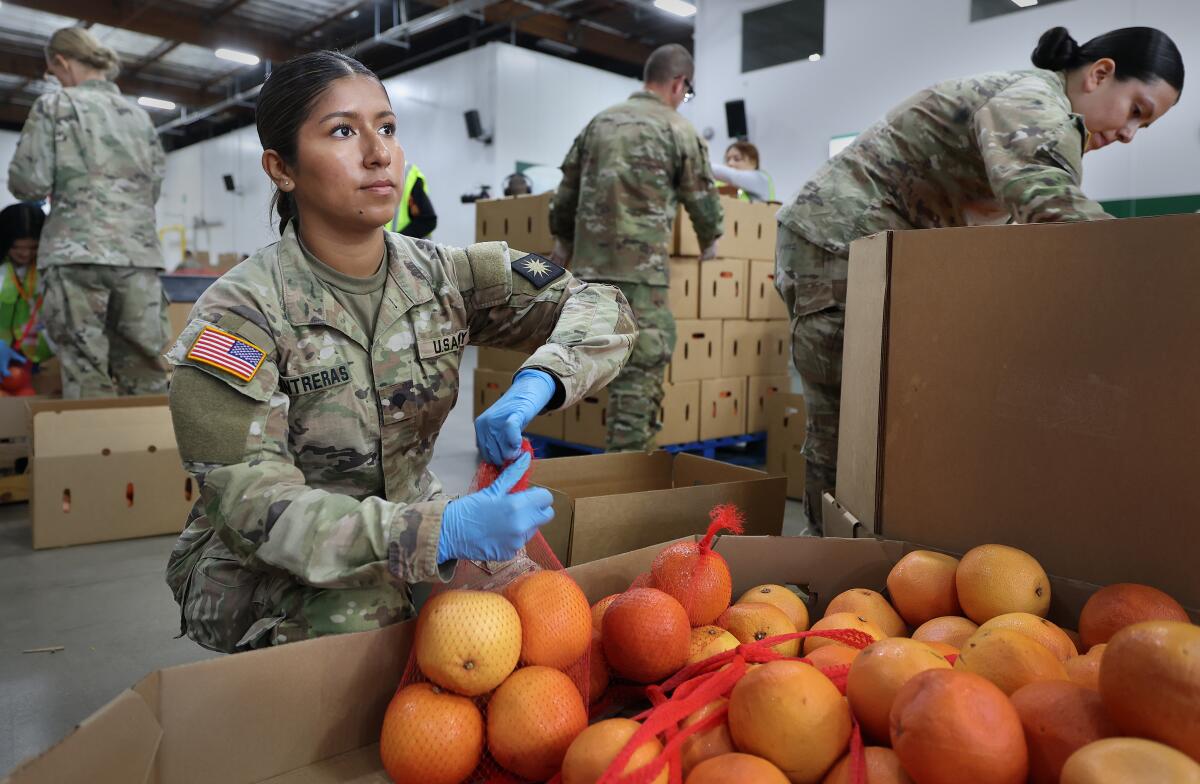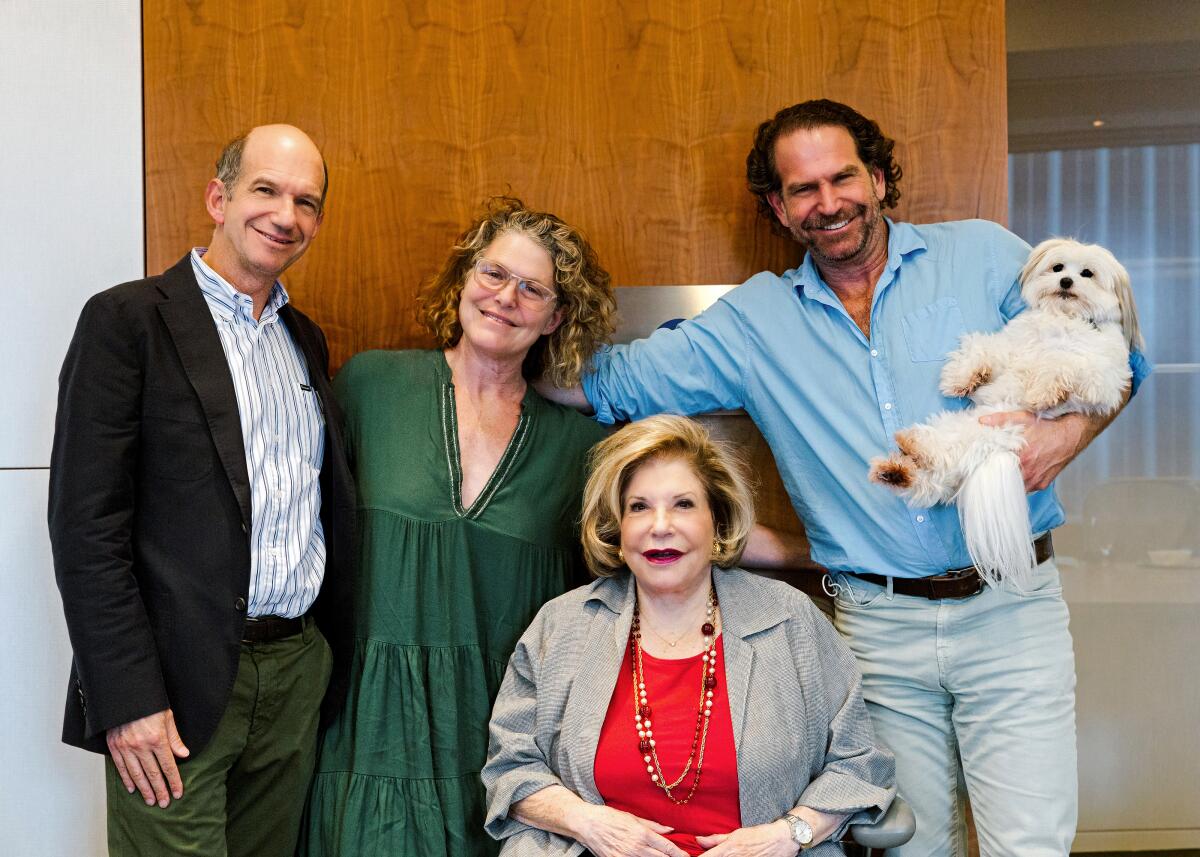Hunger looms as millions prepare to lose food aid amid shutdown
Michaela Thompson, an unemployed mother in the San Fernando Valley, relies on federal assistance to afford the specialized baby formula her 15-month-old daughter needs because of a feeding disorder. At $47 for a five-day supply, it’s out of her reach otherwise.
But with the federal shutdown blocking upcoming disbursements of Supplemental Nutrition Assistance Program benefits — previously known as food stamps — Thompson said she doesn’t know how she’s going to fill her daughter’s bottles.
“It feels like the world is kind of crumbling right now,” she said. “I’m terrified for my family and my daughter.”
Millions of low-income families who rely on SNAP benefits to put food on the table in California and across the country — about 1 in 8 Americans — are confronting similar fears this week, as federal and state officials warn that November funds will not be issued without a resolution to the ongoing federal shutdown and Congress shows no sign of a breakthrough.
Gov. Gavin Newsom and state Atty. Gen. Rob Bonta announced Tuesday that California is joining other Democrat-led states in suing the Trump administration to force SNAP payments through the use of contingency funds, but the litigation — even if successful — won’t prevent all the disruptions.
Army Spc. Jazmine Contreras, center, and Pfc. Vivian Almaraz, right, of the 40th Division Sustainment Brigade, Army National Guard, Los Alamitos, help workers and volunteers pack boxes of produce at the Los Angeles Regional Food Bank on Friday.
(Allen J. Schaben / Los Angeles Times)
It is already too late for some of the 5.5 million California residents — including 2 million children — who rely on such benefits to receive them in time to buy groceries after Friday, when many will have already used up their October benefits, state officials said. Advocates warned of a tidal wave of need as home pantries and CalFresh cards run empty — which they said is no longer a risk but a certainty.
“We are past the point at which it is possible to prevent harm,” said Andrew Cheyne, managing director of public policy at the organization End Child Poverty California.
About 41.7 million Americans were served through SNAP per month in fiscal 2024, at an annual cost of nearly $100 billion, according to the U.S. Department of Agriculture.
State officials, local governments and nonprofit organizations are scrambling to get the word out to families and to redirect millions of dollars in emergency funding to stock more food at local food banks or load gift cards for the neediest families, but many say the capacity to respond is insufficient — and are bracing for a deluge of need.
“People really don’t understand the scale and scope of what is happening and the ripple effect it will have on the economy and with people just meeting their basic needs,” said Angela F. Williams, president and chief executive of United Way.
Already, United Way is seeing an uptick in calls to its 211 centers nationwide from people looking for help with groceries, utility bills and rent, Williams said. “There’s a critical crisis that has been brewing for a while, and it’s reaching a fevered pitch.”
Cheyne said many families are well aware of the looming disruption to aid and scrambling to prepare, including by going to state food banks for groceries. Newsom has activated the National Guard to help handle that influx in California.
However, Cheyne said many others will likely find out about the disruption while standing in grocery store checkouts.
“We anticipate a huge surge in people extremely upset to find out that they’ve literally shopped, and the groceries are in their cart, and their kids are probably with them, and then they get to the checkout, and then it’s, ‘transaction denied: insufficient funds.’”
Children and older people — who make up more than 63% of SNAP recipients in California — going hungry across America is a dire enough political spectacle that politicians of both parties have worked aggressively to prevent it in the past, including during previous government shutdowns. But this time around, they seem resigned to that outcome.
Members of the military and their families receive food donated by Feeding San Diego food bank on Friday.
(Sandy Huffaker / AFP / Getty Images)
Republicans and Democrats have been unable to reach a deal on the budget impasse as Democrats fight Republicans over their decision to slash healthcare subsidies relied on by millions of Americans. With no end in sight to the nearly month-long shutdown, federal workers who are either furloughed or working without pay — including many in California — are facing financial strain and increasingly showing up at food pantries, officials said.
A deluge of SNAP recipients will only add to the lines, and some food bank leaders are becoming increasingly worried about security at those facilities if they are overwhelmed by need.
Pointing fingers
In a statement posted to its website Monday, the Department of Agriculture wrote that Senate Democrats had repeatedly voted not to restore the SNAP funds by passing a short-term Republican spending measure.
“Bottom line, the well has run dry,” it said. “We are approaching an inflection point for Senate Democrats.”
The Trump administration had said Friday that it cannot legally dip into contingency funds to continue funding SNAP into November, even as it uses nontraditional means to pay for the salaries of active-duty military and federal law enforcement.
House Speaker Mike Johnson (R-La.) walks through Statuary Hall at the Capitol on Tuesday.
(Samuel Corum / Bloomberg / Getty Images)
The administration has used tariff revenue to temporarily fund the Women, Infants and Children Nutrition Program, which serves about 6.7 million women and children nationally, though it is unclear how long it will continue do so. The California Department of Public Health said the state WIC program, which supports about half of all babies born in California, should “remain fully operational through Nov. 30, assuming no unexpected changes.”
On Capitol Hill, negotiations to end the shutdown have mostly ground to a halt. Speaker Mike Johnson (R-La.) once again refused to call House members back into session this week, sparking criticism from Democrats and some Republicans who want to negotiate a deal to reopen the government. In the Senate, negotiations remain at a stalemate.
Senate Democrats, meanwhile, have relentlessly blamed President Trump and his administration for causing the disruption to food aid, just as they have blamed the president for the shutdown overall.
“Donald Trump has the power to ensure 40 million people don’t go hungry during the shutdown. But he wishes to inflict the maximum pain on those who can least afford it. He won’t fund food. But he’s happy to build a golden ballroom,” Sen. Adam Schiff (D-Calif.) wrote Monday on X.
Schiff was referring to a $250-million ballroom Trump has planned for the White House, which he recently set into motion by demolishing the historic East Wing.
A member of the U.S. Navy waits in line to receive food from volunteers with Feeding San Diego food bank.
(Sandy Huffanker / AFP / Getty Images)
State and local responses
States have responded to the looming cut in different ways. Some have promised to backfill SNAP funding from their own coffers, though federal officials have warned they will not be reimbursed.
Newsom has stood up the National Guard and directed tens of millions of dollars to state food banks, but has made no promises to directly supplement missing SNAP benefits with state dollars — despite advocacy groups calling on him to do so.
On Friday, dozens of organizations wrote a letter to Newsom and other state officials estimating the total amount of lapsed funding for November to be about $1.1 billion, and calling on them to use state funds to cover the total amount to prevent “a crisis of unthinkable magnitude.”
Carlos Marquez III, executive director of the County Welfare Directors Assn. of California, said counties and other local agencies are responding in a number of ways, including making contributions to local food banks and looking for ways to redirect local funds — and find matching philanthropic dollars — to directly backfill missing SNAP benefits.
Los Angeles County, which has about 1.5 million SNAP recipients, has already approved a $10-million expenditure to support local food banks, its Department of Children and Family Services has identified an additional $2 million to redirect, and its partners providing managed care plans to SNAP recipients have committed another $5 million, he said.
He said his group has advocated for Newsom to declare a statewide emergency, which would help equalize the response statewide and allow for mutual aid agreements between wealthier and poorer areas.
He said his group also is advocating for the state to begin using school lunch programs to direct additional food to families with younger children at home, and to work with local senior care facilities to make sure elderly SNAP recipients are also being helped.
What comes next?
Williams, of United Way, said the organization’s local chapters are “looking for partners on the ground” to provide additional support moving forward, as needs will persist.
“It seems like every day the needs just become more and more pressing, and I’m concerned, honestly, not only about the economic toll that is being taken on individuals, I’m concerned about the mental health and emotional toll this is taking on people,” Williams said. “My hope is that people from all sectors will step up and say, ‘How can we be good neighbors?’”
On Friday, National Guard troops began a 30-day deployment at the Los Angeles Regional Food Bank, where they are sorting produce and packing food boxes. Due to “heightened concern” in the community about the military’s role in Trump’s immigration crackdown, the troops will be working in warehouses and not interacting directly with the public, said Chief Executive Michael Flood.
Flood said there has already been a surge in demand from laid-off federal workers in Los Angeles, but he’s expecting demand to increase markedly beginning Saturday, and building up distribution capacity similar to what was in place during the height of the COVID-19 pandemic — which seemed odd, considering “this is a man-made disaster.”
“It doesn’t have to happen,” Flood said. “Folks in D.C. can prevent this from happening.”





